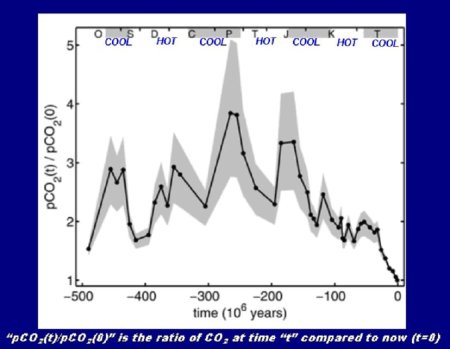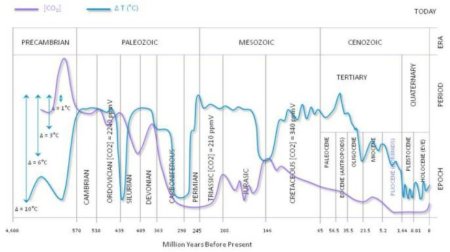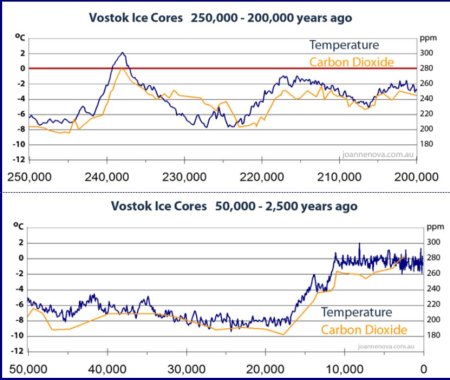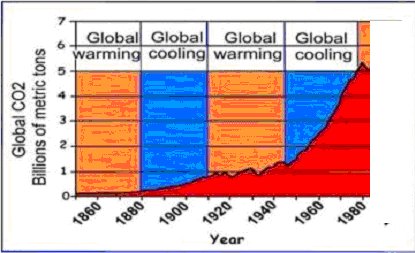Climate-change facts: Temperature is not determined by carbon dioxide
Posted by Henry Bauer on 2017/05/02
The mainstream claims about carbon dioxide , global warming, and climate change, parroted by most media and accepted by most of the world’s governments, are rather straightforward: carbon dioxide released in the burning of “fossil fuels” (chiefly coal and oil) drives global warming because CO2 is a “greenhouse gas”, absorbing heat that would otherwise radiate harmlessly out into space. Since the mid-19th century, when the Industrial Revolution set off this promiscuous releasing of CO2, the Earth has been getting hotter at an unprecedented pace.
The trouble with these claims is that actual data demonstrate that global temperature is not determined by the amount of CO2 in the atmosphere.
For example, during the past 500 million years, CO2 levels have often been much higher than now, including times when global temperatures were lower (1):
“The gray bars at the top … correspond to the periods when the global climate was cool; the intervening white space corresponds to the warm modes … no correspondence between pCO2 and climate is evident …. Superficially, this observation would seem to imply that pCO2 does not exert dominant control on Earth’s climate …. A wealth of evidence, however, suggests that pCO2 exerts at least some control …. [but this Figure] … shows that the ‘null hypothesis’ that pCO2 and climate are unrelated cannot be rejected on the basis of this evidence alone.” [To clarify convoluted double negative: All the evidence cited in support of mainstream claims is insufficient to over-rule what the above Figure shows, that CO2 does not determine global temperatures (the “null hypothesis”).]
Again, with temperature levels in quantitative detail (2):
Towards the end of the Precambrian Era, CO2 levels (purple curve) were very much higher than now while temperatures (blue curve) were if anything lower. Over most of the more recent times, CO2 levels have been very much lower while temperatures most of the time were considerably higher.
Moreover, the historical range of temperature fluctuations makes a mockery of contemporary mainstream ambitions to prevent global temperatures rising by as much as 2°C; for most of Earth’s history, temperatures have been about 6°C higher than at present.
Cause precedes effect
The data just cited do not clearly demonstrate whether rising CO2 brings about subsequent rises in temperature — or vice versa. However, ice-core data back as far as 420,000 years do show which comes first: temperature changes are followed by CO2 changes (3):
On average, CO2 rises lag about 800 years behind temperature rises; and CO2 levels also decline slowly after temperatures have fallen.
Since the Industrial Revolution
Over the last 150 years, global temperatures have risen, and levels of CO2 have risen. This period is minuscule by comparison to the historical data summarized above. Crucially, what has happened in this recent sliver of time cannot be compared directly to the past because the historical data are not fine-grained enough to discern changes over such short periods of time. What is undisputed, however, is that CO2 and temperature have not increased in tandem in this recent era, just as over geological time-spans. From the 1940s until the 1970s, global temperatures were falling, and mainstream experts were telling the mass media that an Ice Age was threatening (4) — at the same time as CO2 levels were continuing their merry rise with fossil fuels being burnt at an ever-increasing rate (5):
“1945 to 1977 cool period with soaring CO2 emissions. Global temperatures began to cool in the mid–1940’s at the point when CO2 emissions began to soar … . Global temperatures in the Northern Hemisphere dropped about 0.5°C (0.9° F)
from the mid-1940s until 1977 and temperatures globally
cooled about 0.2°C (0.4° F) …. Many of the world’s glaciers advanced during this time and recovered a good deal
of the ice lost during the 1915–1945 warm period”.
Furthermore (5):
“Global cooling from 1999 to 2009. No global warming has occurred above the 1998 level. In 1998, the PDO [Pacific Decadal Oscillation] was in its warm mode. In 1999, the PDO flipped from its warm mode into its cool mode and satellite imagery confirms that the cool mode has become firmly entrenched since then and global cooling has deepened significantly in the past few years.”
In short:
–> Global temperatures have often been high
while CO2 levels were low, and vice versa
–> CO2 levels rise or fall after temperatures have risen or fallen
–> CO2 levels have risen steadily but temperatures decreased
between the 1940s and 1970s, and since about 1998
there has been a pause in warming, perhaps even cooling
Quite clearly, CO2 is not the prime driver of global temperature. Data, facts, about temperature and CO2 demonstrate that something else has far outweighed the influence of CO2 levels in determining temperatures throughout Earth’s history, including since the Industrial Revolution. “Something else” can only be natural forces. And indeed there are a number of known natural forces that affect Earth’s temperature; and many of those forces vary cyclically over time. The amount of energy radiated to Earth by the Sun varies in correlation with the 11-year periodic cycle of sun-spots, which is fairly widely known; but there are many other cycles known only to specialists, say the 9-year Lunisolar Precession cycle; and these natural forces have periodically warmed and cooled the Earth in cycles of glaciation and warmth at intervals of roughly 100,000 – 120,000 years (the Milankovitch Cycles), with a number of other cycles superposed on those (6).
So the contemporary mainstream view, the so-called “scientific consensus”, is at odds with the evidence, the facts.
That will seem incredible to many people, who might well ask how that could be possible. How could “science” be so wrong?
In brief: because of facts about science that are not much known outside the ranks of historians and philosophers and sociologists of science (7): that the scientific consensus at any given time on any given matter has been wrong quite often over the years and centuries (8); and that science nowadays has become quite different from our traditional view of it (9).
____________________________________
(1) Daniel H. Rothman, Proceedings of the National Academy of Sciences of the United States of America, 99 (2002) 4167-71, doi: 10.1073/pnas.022055499
(2) Nahle Nasif, “Cycles of Global Climate Change”, Biology Cabinet Journal Online, #295 (2007); primary sources of data are listed there
(3) The 800 year lag in CO2 after temperature – graphed; primary sources are cited there
(4) History rewritten, Global Cooling from 1940 – 1970, an 83% consensus, 285 papers being “erased”;
1970s Global Cooling Scare;
1970s Global Cooling Alarmism
(5) Don Easterbrook,
“Global warming and CO2 during the past century”
(6) David Dilley, Natural Climate Pulse, January 2012;
(7) For example:
What everyone knows is usually wrong (about science, say)
Scientific literacy in one easy lesson
The culture and the cult of science
(8) For example:
Bernard Barber, “Resistance by scientists to scientific discovery”,
Science, 134 (1961) 596–602.
Gunther Stent, “Prematurity and uniqueness in
scientific discovery”, Scientific American,
December 1972, pp. 84-93.
Hook, Ernest B. (ed), Prematurity in Scientific Discovery:
On Resistance and Neglect,
University of California Press, 2002.
Science: A Danger for Public Policy?!
(9) For example:
How Science Has Changed — notably since World War II
The Science Bubble
The business of for-profit “science”
From Dawn to Decadence: The Three Ages of Modern Science









mountainmere said
“In this complex multifactor system, what is the likelihood of the climate…is controlled by this 2% perturbation in a single variable? Believing this is pretty close to believing in magic. Instead, you are told that it is believing in ‘science.’ Such a claim should be a tip-off that something is amiss. After all, science is a mode of inquiry rather than a belief structure.”
Thoughts on the Public Discourse over Climate Change, by Richard Lindzen
LikeLike
Henry Bauer said
mountainmere:
THANKS for that link to excellent article
LikeLike